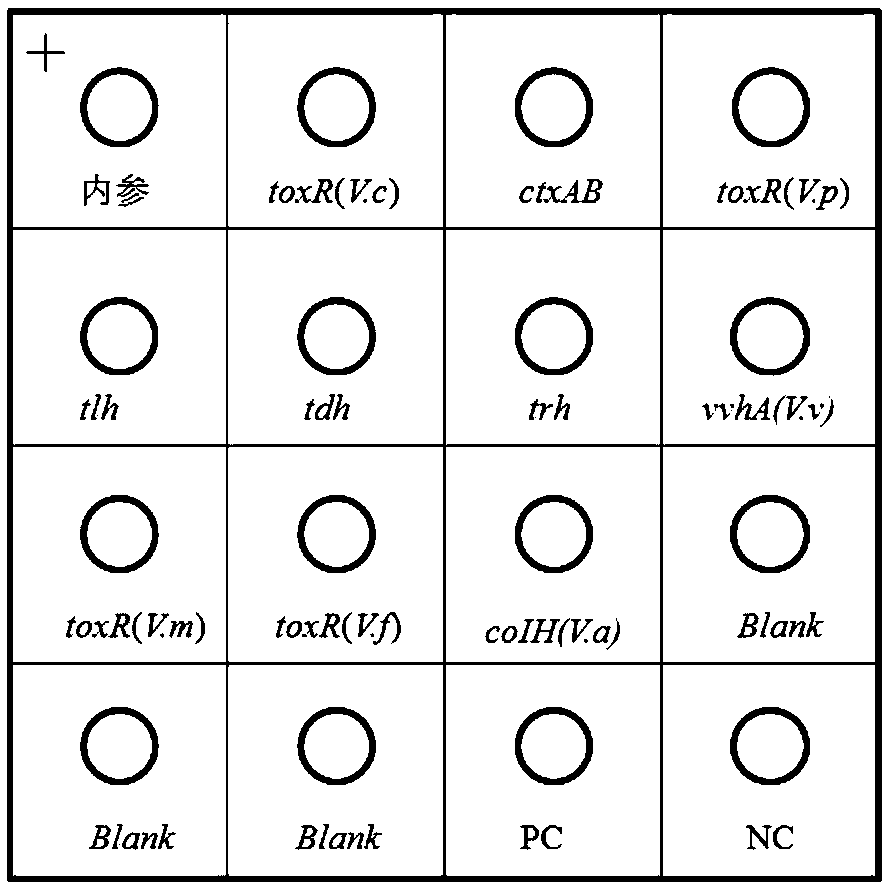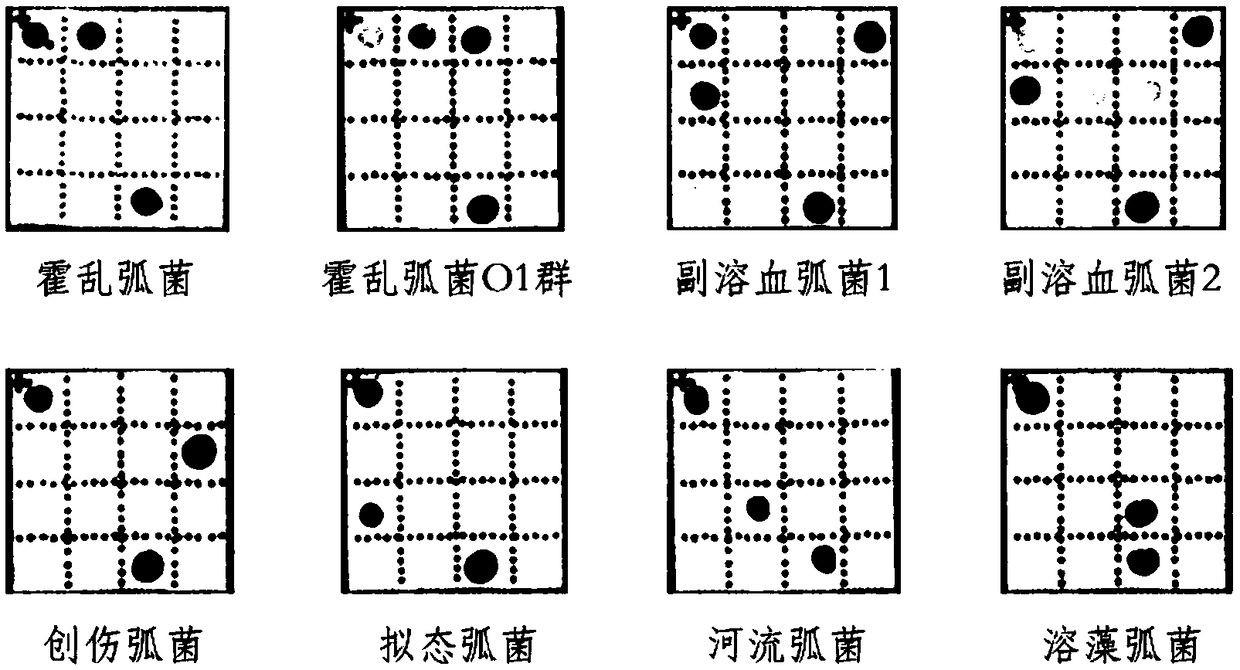Method for detecting pathogenic vibrios
A technology for pathogenic Vibrio and hemolytic Vibrio, which is applied in the directions of microorganism-based methods, biochemical equipment and methods, and microbial determination/inspection, which can solve the problem of prone to false positives, high detection limits and long detection times To avoid non-specific amplification, high specificity and sensitivity, and improve detection sensitivity
- Summary
- Abstract
- Description
- Claims
- Application Information
AI Technical Summary
Problems solved by technology
Method used
Image
Examples
Embodiment 1
[0147] This embodiment describes a kit for detecting pathogenic Vibrio, which includes a nucleic acid combination and a membrane chip.
[0148] Wherein, the nucleic acid combination includes the following primer pairs, and the base sequences (5'-3') of the upstream primer and the downstream primer of each primer pair are as follows:
[0149] First primer pair for Vibrio cholerae toxR gene (toxR(V.c)):
[0150] Upstream primer: ATTGACGGCTACGCCATCGACA (SEQ ID NO.1), downstream primer: ACCGCAGCCCAGCCAATGTTG (SEQ ID NO.2);
[0151] Second primer pair for detection of Vibrio cholerae ctxAB gene:
[0152] Upstream primer: CATCTGGATGAGGACTGTATGC (SEQ ID NO.3), downstream primer: GCCAAGAGGACAGAGTGAGTA (SEQ ID NO.4);
[0153] The third primer pair for detecting Vibrio parahaemolyticus toxR gene (toxR(V.p)):
[0154] Upstream primer: GAAGGCAGCCAGATGTTGATT (SEQ ID NO.5), downstream primer: TCTCAGTTCCGTCAGATTGGT (SEQ ID NO.6);
[0155] The fourth primer pair used to detect the tlh gen...
Embodiment 2
[0206] The method for detecting pathogenic Vibrio in the sample to be tested by using the above kit is as follows:
[0207] 2.1 Use 3% sodium chloride alkaline peptone water to carry out mixed bacterial enrichment culture on the sample, and take the cultured mixed bacterial solution for DNA extraction; this step is carried out as required.
[0208] 2.1 Extract the genomic DNA of the sample to be tested according to the CTAB method, and use an ultra-micro spectrophotometer to measure the mass concentration of the DNA solution for later use.
[0209] 2.2 Multiplex PCR system and conditions
[0210] The reaction system of PCR amplification:
[0211] 10×PCR Buffer (with Mg 2+ , containing UNG enzyme): 5 μL;
[0212] dNTP (2.5mM each): 5μL;
[0213] Taq DNA polymerase (5U / μL): 0.5 μL;
[0214] Biotin-labeled downstream primers (20 μM): 1.2 μL; upstream primers (20 μM): 1 μL; instructions: 11 primer pairs (provided in Example 1) were added, each primer pair had 1.2 μL of downst...
Embodiment 3
[0249] According to the instructions of Tiangen Biochemical Technology (Beijing) Co., Ltd. Bacterial Genomic DNA Extraction Kit (Cat. No.: DP302), extract different pathogenic Vibrio standard strains (Vibrio cholerae (without virulence factor ctxAB), Vibrio cholerae O1 group) (with virulence factors ctxAB), Vibrio parahaemolyticus 1 (without virulence factors tdh or trh), Vibrio parahaemolyticus 2 (with virulence factors tdh and trh), Vibrio vulnificus, Vibrio mimicus, Vibrio riverines and Vibrio alginolyticus) genomic DNA. The concentration and quality of the extracted DNA were measured with an ultra-micro spectrophotometer (Thermo NanoDrop 2000) for later use.
[0250] With the kit of Example 1, detect according to the method of Example 2, according to the color development of the hybridization point with reference to figure 1 Interpret the results, the results are as follows figure 2 shown.
[0251] figure 2 Vibrio cholerae (non-V. cholerae O1 or V. cholerae O139 grou...
PUM
 Login to View More
Login to View More Abstract
Description
Claims
Application Information
 Login to View More
Login to View More - R&D
- Intellectual Property
- Life Sciences
- Materials
- Tech Scout
- Unparalleled Data Quality
- Higher Quality Content
- 60% Fewer Hallucinations
Browse by: Latest US Patents, China's latest patents, Technical Efficacy Thesaurus, Application Domain, Technology Topic, Popular Technical Reports.
© 2025 PatSnap. All rights reserved.Legal|Privacy policy|Modern Slavery Act Transparency Statement|Sitemap|About US| Contact US: help@patsnap.com



